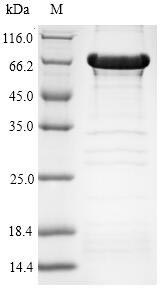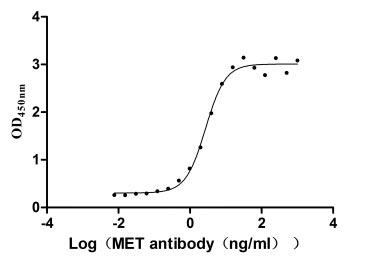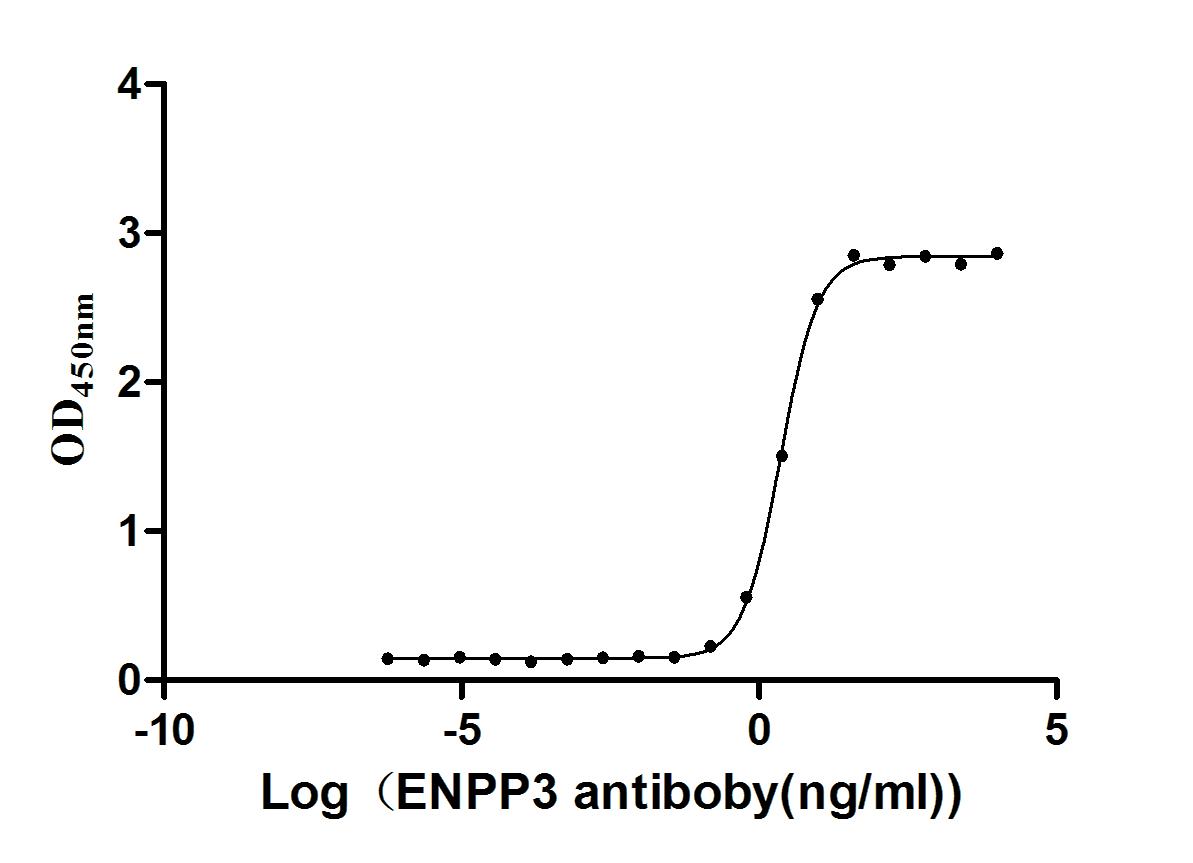Recombinant Human Histone deacetylase 6 (HDAC6), partial
In Stock-
货号:CSB-EP010242HU
-
规格:¥1344
-
图片:
-
其他:
产品详情
-
纯度:Greater than 90% as determined by SDS-PAGE.
-
基因名:
-
Uniprot No.:
-
别名:CPBHM; FLJ16239; HD 6; HD6; HDAC 6; HDAC6; HDAC6_HUMAN; Histone deacetylase 6 (HD6); Histone deacetylase 6; JM 21; JM21; KIAA0901; OTTHUMP00000032398; OTTHUMP00000197663; PPP1R90; Protein phosphatase 1 regulatory subunit 90
-
种属:Homo sapiens (Human)
-
蛋白长度:Partial
-
来源:E.coli
-
分子量:70.1 kDa
-
表达区域:1-488aa
-
氨基酸序列MTSTGQDSTTTRQRRSRQNPQSPPQDSSVTSKRNIKKGAVPRSIPNLAEVKKKGKMKKLGQAMEEDLIVGLQGMDLNLEAEALAGTGLVLDEQLNEFHCLWDDSFPEGPERLHAIKEQLIQEGLLDRCVSFQARFAEKEELMLVHSLEYIDLMETTQYMNEGELRVLADTYDSVYLHPNSYSCACLASGSVLRLVDAVLGAEIRNGMAIIRPPGHHAQHSLMDGYCMFNHVAVAARYAQQKHRIRRVLIVDWDVHHGQGTQFTFDQDPSVLYFSIHRYEQGRFWPHLKASNWSTTGFGQGQGYTINVPWNQVGMRDADYIAAFLHVLLPVALEFQPQLVLVAAGFDALQGDPKGEMAATPAGFAQLTHLLMGLAGGKLILSLEGGYNLRALAEGVSASLHTLLGDPCPMLESPGAPCRSAQASVSCALEALEPFWEVLVRSTETVERDNMEEDNVEESEEEGPWEPPVLPILTWPVLQSRTGLVYDQN
Note: The complete sequence including tag sequence, target protein sequence and linker sequence could be provided upon request. -
蛋白标签:N-terminal 6xHis-SUMO-tagged
-
产品提供形式:Liquid or Lyophilized powder
Note: We will preferentially ship the format that we have in stock, however, if you have any special requirement for the format, please remark your requirement when placing the order, we will prepare according to your demand. -
缓冲液:Tris-based buffer,50% glycerol
-
储存条件:Store at -20°C/-80°C upon receipt, aliquoting is necessary for mutiple use. Avoid repeated freeze-thaw cycles.
-
保质期:The shelf life is related to many factors, storage state, buffer ingredients, storage temperature and the stability of the protein itself.
Generally, the shelf life of liquid form is 6 months at -20°C/-80°C. The shelf life of lyophilized form is 12 months at -20°C/-80°C. -
货期:3-7 business days
-
注意事项:Repeated freezing and thawing is not recommended. Store working aliquots at 4°C for up to one week.
-
Datasheet & COA:Please contact us to get it.
相关产品
靶点详情
-
功能:Responsible for the deacetylation of lysine residues on the N-terminal part of the core histones (H2A, H2B, H3 and H4). Histone deacetylation gives a tag for epigenetic repression and plays an important role in transcriptional regulation, cell cycle progression and developmental events. Histone deacetylases act via the formation of large multiprotein complexes. In addition to histones, deacetylates other proteins: plays a central role in microtubule-dependent cell motility by mediating deacetylation of tubulin. Promotes deacetylation of CTTN, leading to actin polymerization, promotion of autophagosome-lysosome fusion and completion of autophagy. Involved in the MTA1-mediated epigenetic regulation of ESR1 expression in breast cancer. In addition to its protein deacetylase activity, plays a key role in the degradation of misfolded proteins: when misfolded proteins are too abundant to be degraded by the chaperone refolding system and the ubiquitin-proteasome, mediates the transport of misfolded proteins to a cytoplasmic juxtanuclear structure called aggresome. Probably acts as an adapter that recognizes polyubiquitinated misfolded proteins and target them to the aggresome, facilitating their clearance by autophagy.
-
基因功能参考文献:
- In this review, we describe the HDACs, their inhibitors, and the recent advances of HDAC6 inhibitors, their mechanisms of action and role in lymphoproliferative disorders. PMID: 30096875
- Mycobacterium tuberculosis infection disturbs the HDAC6/HDAC11 levels to induce IL-10 expression in macrophages. PMID: 29523311
- Histone deacetylase 6 (HDAC6) inhibition enhanced glioma stem cells (GSCs) radiosensitivity via inactivating sonic hedgehog protein (SHH)/glioma-associated oncogene homolog 1 (Gli1) pathway. PMID: 29222038
- Cortactin (CTTN) silencing in megakaryocyte (MK) phenocopies histone deacetylase 6 (HDAC6) inactivation and knockdown leads to a strong proplatelet formation (PPF) defect. PMID: 29176689
- Hdac5 and Hdac6 expression are required for the adequate expression of Icer and adipocyte function. Altered adipose expression of the two Hdacs in obesity by hypoxia may contribute to the development of metabolic abnormalities. PMID: 27900262
- this study reports that HDAC6 is involved in reactive oxygen species-NF-kappaB signaling pathway related to pro-inflammatory cytokine expression PMID: 29414656
- DTBP represents a promising lead structure for the development of HDAC6 inhibitors, with an improvement in specificity conferred by modification of the cap group. We propose for the first time that the underlying mechanism of the anticancer activity of DTBP is attributed to inhibition of HDAC6 activity. PMID: 29427610
- To the best of our knowledge, this is the first report of an HDAC6 selective inhibitor bearing a hydrazide ZBG. Its capability to passively cross the blood-brain barrier (BBB), as observed through PAMPA assays, and its low cytotoxicity in vitro, suggested its potential for drug development. PMID: 27404291
- we observed an homologous-recombination deficiency (HRD)-associated level of HDAC6 overexpression, which supports a potential role for the effectiveness of HDAC inhibitor treatment in HRD tumors that are characterized by low levels of H4 lysine acetylation. PMID: 28866885
- High expression of HDAC6 is associated with chondrosarcoma. PMID: 28586053
- HDAC6, a primarily cytoplasmic deacetylase, mediates TGF-beta1-induced EMT in human lung cancer cells via activation of Notch1. PMID: 27499032
- Results confirm histone deacetylase 9 (HDAC9) as a major risk gene for large artery stroke with an association in the 3'-UTR. PMID: 28265093
- deletion or inhibition of the cytoplasmic shuttling factor HDAC6 suppressed neuritic tau bead formation in neurons. PMID: 28854366
- At the recommended phase II dose of ricolinostat of 160 mg daily, the combination with bortezomib and dexamethasone is safe, well-tolerated, and active, suggesting that selective inhibition of HDAC6 is a promising approach to multiple myeloma therapy. PMID: 28053023
- Increased HDAC6 expression is associated with renal cell carcinoma. PMID: 28128740
- Our work shows that RanBPM, together with the CTLH complex, associates with HDAC6 and restricts cell migration through inhibition of HDAC6 activity. This study uncovers a novel function for the CTLH complex and suggests that it could have a tumour suppressive role in restricting HDAC6 oncogenic properties. PMID: 28668087
- Results provide evidence that HDAC6 mediates the HIV-1 Tat-induced expression of chemokines by regulating reactive oxygen species-Nox2-based NADPH oxidase pathways in astrocytes. Furthermore, there is crosstalk between HDAC6 and NADPH oxidase in HIV-1 Tat-induced chemokine expression in astrocytes. PMID: 28499252
- The development of this ACY-1215-resistant cell line has provided valuable insights into the mechanistic role of HDAC6 in lymphoma and offered a novel method to identify rational synergistic drug combinations. PMID: 27993968
- rhTGF-beta1 affects sensitivity of human osteoblasts towards mechanical stimuli by damaging the microtubule structure of primary cilia in a HDAC6-dependent manner. PMID: 28271209
- In conclusion, HDAC6 might enhance aggressive melanoma cells progression via interacting with PTPN1, which was independent of its histone modifying activity. PMID: 29278704
- Using motor neurons derived from induced pluripotent stem cells from patients with amyotrophic lateral sclerosis and FUS mutations, axonal transport defects could be successfully rescued by HDAC6 inhibitors or silencing HDAC6. PMID: 29021520
- Data show that selective histone deacetylase 6 (HDAC6) inhibition or knockdown of HDAC6 expression was able to prevent caspase 3 activation in lung endothelial cells and maintain lung endothelial cell-cell junctions. PMID: 27419634
- The HDAC6 Inhibitor Tubacin Induces Release of CD133(+) Extracellular Vesicles From Cancer Cells. PMID: 28452069
- MicroRNA-22 Promoted Osteogenic Differentiation of Human Periodontal Ligament Stem Cells by Targeting HDAC6 PMID: 28195408
- A decrease of HDAC6 expression caused by Helicobacter pylori infection is associated with oncogenic transformation in gastric cancer. PMID: 28700998
- these results suggest that HDAC1 and HDAC6 may play a role in clear cell renal cell carcinoma biology PMID: 27506904
- Genetic abrogation of HDAC6 in primary melanoma samples and cell lines, down-regulates the expression of PD-L1, an important co-stimulatory molecule expressed in cancer cells, which activates the inhibitory regulatory pathway PD-1 in T-cells. PMID: 26775640
- activation appears to be a key survival mechanism for HDAC6 inhibitor treatment. PMID: 27362804
- ARID1A mutation inactivates the apoptosis-promoting function of p53 by upregulating HDAC6, indicating that pharmacological inhibition of HDAC6 is a therapeutic strategy for ARID1A-mutated cancers. PMID: 28737768
- 7-amino-4-methylcoumarin did not affect acetyllysine preference in a multiply acetylated substrate. In contrast, AMC significantly enhanced KDAC6 substrate affinity, greatly reduced Sirt1 activity, eliminated the substrate sequence specificity of KDAC4, and had no consistent effect with KDAC8 substrates. PMID: 28749131
- deacetylation of MST1 mediated by HBXIP-enhanced HDAC6 results in MST1 degradation in a chaperone-mediated autophagy (CMA). manner in promotion of breast cancer growth. PMID: 26657153
- Suggest that HDAC4 and HDAC6 are guardians of irradiation-induced DNA damage and stemness, thus promoting radioresistance in glioblastoma cells. PMID: 28342984
- These results indicate overlapping and distinct functions of HDAC6 and SIRT2. PMID: 27311481
- Results provide evidence that HDAC6 could regulate HMGN2 acetylation levels and binding to Stat5a-responsive promoters, and therefore, Stat5a transcriptional activity in breast cancer cells. PMID: 27358110
- HDAC6 promotes glioblastoma cell proliferation and confers resistance to temozolomide. PMID: 27267806
- The s characterized the histone deacetylase 6-interacting proteins in LNCaP metastatic prostate cancer cells and found that histone deacetylase 6 interacts with proteins involved in several cellular processes, including autophagy. PMID: 26643866
- HDAC6 may represent an optimal target for future immunosuppressant therapeutics with a particular role in transplantation. PMID: 27222932
- a combination regimen of bortezomib and the histone deacetylase inhibitor trichostatin A abolished HDAC6 activity and decreased autophagy induction while significantly enhancing bortezomib-induced apoptosis in HNSCC cells. PMID: 27369083
- this review highlights current data illustrating the complexity and importance of HDAC6 in viral pathogenesis. [review] PMID: 27959772
- Systemic lupus erythematosus patients had higher methylation in the HDAC6 promoter and lower HDAC6 mRNA expression than the controls. These changes may be related to the susceptibility of SLE. However, they are not associated with the disease activity of SLE. PMID: 26461065
- Cutaneous T-cell lymphoma (CTCL) pathogenesis remains unknown, and there are no curative therapies. Our findings not only demonstrate a critical role for IL15-mediated inflammation in cutaneous T-cell lymphomagenesis, but also uncover a new oncogenic regulatory loop in CTCL involving IL15, HDAC1, HDAC6, and miR-21 that shows differential sensitivity to isotype-specific HDAC inhibitors PMID: 27422033
- HDAC6 confers resistance to vemurafenib in BRAF-mutant melanoma cells. PMID: 28035401
- The inhibition of HDAC6 may be a promising strategy for the treatment of lung adenocarcinoma. PMID: 27221381
- Data show that expressions of histone deacetylase 6 protein (HDAC6) and c-myc protein are increased in fibroblasts transformed with activated K-ras protein. PMID: 26848526
- Overexpression of HDAC6 confers non-small cell lung cancer resistance to sorafenib. PMID: 27090797
- these data indicate that HDAC6, and acetylated alpha-tubulin, are important regulator of adipocyte differentiation. PMID: 26363102
- HDAC5 and HDAC6 were highly expressed in melanoma cells but exhibited low expression levels in normal skin cells. PMID: 26747087
- Study found that HDAC6 was significantly down-regulated in hepatocellular carcinoma cells (HCC) and the low expression of HDAC6 was closely associated with high recurrence rate of HCC patients with liver transplantation. PMID: 26086159
- results provide new mechanistic insights into the understanding that deacetylation of HSPA5 by HDAC6 facilitates GP78-mediated HSPA5 ubiquitination PMID: 26119938
- TGF-beta increased activity of HDAC6 without affecting its expression levels. PMID: 26763233
显示更多
收起更多
-
相关疾病:Chondrodysplasia with platyspondyly, distinctive brachydactyly, hydrocephaly, and microphthalmia (CDP-PBHM)
-
亚细胞定位:Cytoplasm. Cytoplasm, cytoskeleton. Nucleus. Perikaryon. Cell projection, dendrite. Cell projection, axon.
-
蛋白家族:Histone deacetylase family, HD type 2 subfamily
-
数据库链接:
HGNC: 14064
OMIM: 300272
KEGG: hsa:10013
STRING: 9606.ENSP00000334061
UniGene: Hs.6764
Most popular with customers
-
Recombinant Human Hepatocyte growth factor receptor (MET), partial (Active)
Express system: Mammalian cell
Species: Homo sapiens (Human)
-
Recombinant Human Tumor necrosis factor ligand superfamily member 8 (TNFSF8), partial (Active)
Express system: Mammalian cell
Species: Homo sapiens (Human)
-
Recombinant Human E3 ubiquitin-protein ligase ZNRF3 (ZNRF3), partial (Active)
Express system: Mammalian cell
Species: Homo sapiens (Human)
-
Recombinant Dog Angiopoietin-2 (ANGPT2) (Active)
Express system: Mammalian cell
Species: Canis lupus familiaris (Dog) (Canis familiaris)
-
Express system: Mammalian cell
Species: Homo sapiens (Human)
-
Recombinant Human Zymogen granule protein 16 homolog B (ZG16B) (Active)
Express system: Mammalian cell
Species: Homo sapiens (Human)
-
Recombinant Macaca fascicularis CD44 antigen (CD44), partial (Active)
Express system: Mammalian cell
Species: Macaca fascicularis (Crab-eating macaque) (Cynomolgus monkey)
-
Recombinant Human Claudin-6 (CLDN6)-VLPs, Fluorescent (Active)
Express system: Mammalian cell
Species: Homo sapiens (Human)










f4-AC1.jpg)










